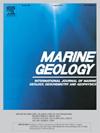马尔马拉海北安那托利亚断层北支(NW tkiye)的长期沉积地震记录
IF 2.2
3区 地球科学
Q2 GEOSCIENCES, MULTIDISCIPLINARY
引用次数: 0
摘要
地质地震记录对概率地震危险性评估具有重要意义。这样的记录可以从海盆和湖盆地震活动引发的浊积岩研究中获得。马尔马拉海(SoM)位于北安那托利亚断层(NAF)上,是水下古地震学研究的重要实验室。这是因为它有2500年的历史。历史地震记录可以与放射性定年的沉积地震记录相关联。此外,深次盆地相对较高的沉积速率(~ 3 mm/yr)使个体事件的识别成为可能。继1912年Mw 7.4 Şarköy-Mürefte和1999年Mw 7.4 Izmit和Mw 7.2 d本文章由计算机程序翻译,如有差异,请以英文原文为准。
Long–term sedimentary earthquake records along the northern branch the North Anatolian Fault in the Sea of Marmara (NW Türkiye)
Geological earthquake records are important for probabilistic seismic risk assessment. Such records can be obtained from studies of turbidites triggered by seismic activity in marine and lake basins. The Sea of Marmara (SoM), located on the North Anatolian Fault (NAF), serves as an important laboratory for subaqueous palaeoseismological research. This is because it has 2500 yrs. of historical earthquake records that can be correlated with radiometrically dated sedimentary earthquake records. Additionally, the relatively high sedimentation rate (∼3 mm/yr) in the deep subbasins allows the recognition of individual events. Following the destructive 1912 Mw 7.4 Şarköy–Mürefte and 1999 Mw 7.4 Izmit and Mw 7.2 Düzce earthquakes, the main submerged part of the NAF in the SoM represents a seismic gap, where the long–term earthquake history is of crucial importance for earthquake risk assessment.
We have studied nine cores recovered along the most active northern strand of the NAF (i.e. the Main Marmara Fault: MMF), using high resolution digital X–ray radiography, μ–XRF core scanning, MSCL physical properties and grain–size analyses. The chronology was determined using accelerated mass spectrometry (AMS) radiocarbon and radionuclide methods. In the cores, coseismic turbidites commonly consist of a basal part with multiple sand–silt laminae above a sharp and often erosional base and an overlying graded mud part (homogenite). The basal parts exhibit high gamma density and MS, and are often enriched in one or more elements, such as Si, K, Fe, Ti, Zr, Ca and Sr, indicative of coarse siliciclastic and carbonate shell fragments.
Radionuclide- and radiocarbon-dated coseismic turbidites in different SoM subbasins extending back to more than 5000 yrs. indicate an average earthquake recurrence time between 220 and 300 yrs. along the different segments of the MMF. These results are compatible with the GPS velocities and geological slip rates. However, the intervals between two consecutive events vary widely between 50 and 695 yrs. for the different northern NAF segments.
Integration of our results with previous studies indicates that the M > 7 events recorded are the 1999, 1509, 1296 and 740 earthquakes on the İzmit Gulf segment; the 1894, 1509, 1343, 1090 and 740 earthquakes on the Prince Islands segment in the Çınarcık Basin; the 1894, 1766, 1509, 989, 869 or 862, 740 and 447 earthquakes on the Central High segment and in the Central Basin; and the 1912, 1766, 1344, 989 and 447 earthquakes on the western Marmara segment. The 1912 Şarköy–Mürefte earthquake record is absent in the Central Basin, which suggests that the earthquake rupture did not extend beyond the western end of the Western High. The distribution of the 2500 yr-long sedimentary earthquake records matched with the historical earthquakes along the MMF indicates the common occurrence of multiple-segment ruptures, and suggests that presently, the most earthquake–prone part of the MMF is the Central High segment, located SW of Istanbul.
求助全文
通过发布文献求助,成功后即可免费获取论文全文。
去求助
来源期刊

Marine Geology
地学-地球科学综合
CiteScore
6.10
自引率
6.90%
发文量
175
审稿时长
21.9 weeks
期刊介绍:
Marine Geology is the premier international journal on marine geological processes in the broadest sense. We seek papers that are comprehensive, interdisciplinary and synthetic that will be lasting contributions to the field. Although most papers are based on regional studies, they must demonstrate new findings of international significance. We accept papers on subjects as diverse as seafloor hydrothermal systems, beach dynamics, early diagenesis, microbiological studies in sediments, palaeoclimate studies and geophysical studies of the seabed. We encourage papers that address emerging new fields, for example the influence of anthropogenic processes on coastal/marine geology and coastal/marine geoarchaeology. We insist that the papers are concerned with the marine realm and that they deal with geology: with rocks, sediments, and physical and chemical processes affecting them. Papers should address scientific hypotheses: highly descriptive data compilations or papers that deal only with marine management and risk assessment should be submitted to other journals. Papers on laboratory or modelling studies must demonstrate direct relevance to marine processes or deposits. The primary criteria for acceptance of papers is that the science is of high quality, novel, significant, and of broad international interest.
 求助内容:
求助内容: 应助结果提醒方式:
应助结果提醒方式:


